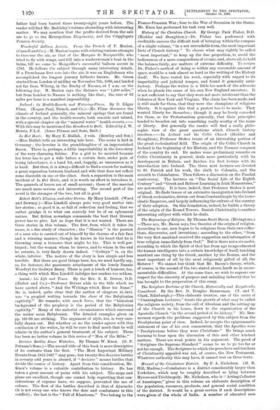An Account of the Church and Parish of St. Giles,
Without Cripple- and more frequent. Every parish has a history that is worth
recording, and all might find, sooner or later, a competent historian. About St. Giles's, Cripplegate, there is, of course, much
to be said. Mr. Baddeley does not attempt to say it all, but what he says is interesting. One naturally turns to the extracts from the Register. The records of the Plague years are nothing less than awful. In 1665 there were nearly eight thousand deaths (though not all ascribed to the Plague), and, it must be remem- bered, in each of the eleven years preceding there had been more than a thousand deaths from the same cause. The population could not have been more than twenty thousand. The churchyard was, of course, overcrowded ; and the corpses had to be buried only just below the surface. Two feet of earth were afterwards put over
it, and burials were forbidden for seven years. The other great
calamity of those days, the Fire, did not greatly damage the parish. The church escaped ; but its windows, it would seem, were broken by the heat, for there is an entry of £29 5s. for reglazing. The cloth and plate, too, were taken away. In 1674, "John Milton, Gentleman," is recorded as having been buried in the chancel. The cause of death is given as "consumption." His father had been buried there twenty-eight years before. The reader will find Mr. Baddeley's volume abounding with interesting matter. We may mention that the profits derived from the sale are to go to the Metropolitan Dispensary, and the Cripplegate Pension Society.



















































 Previous page
Previous page